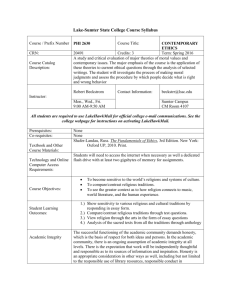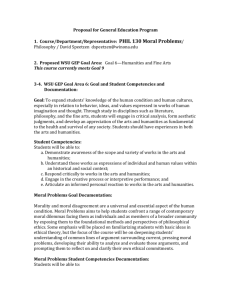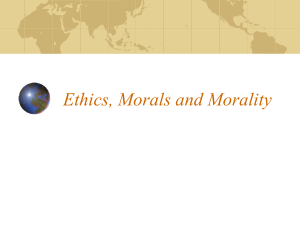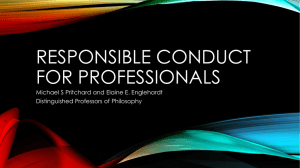Ethics
advertisement
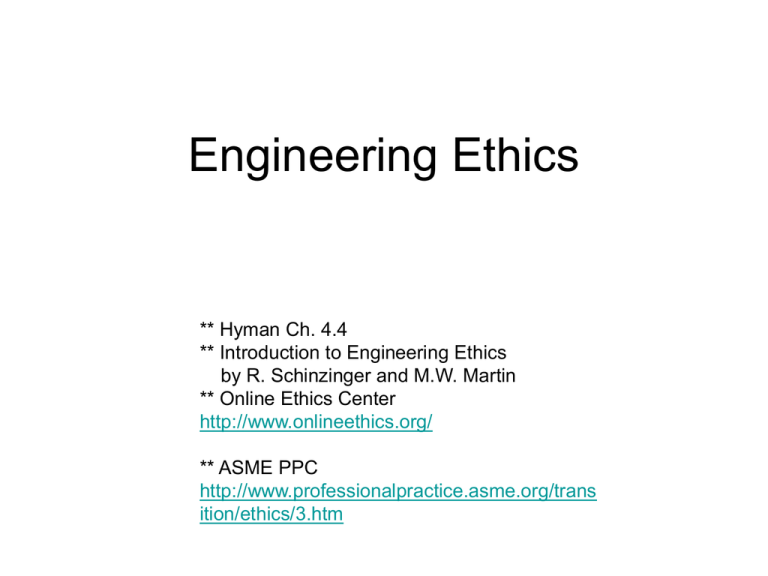
Engineering Ethics ** Hyman Ch. 4.4 ** Introduction to Engineering Ethics by R. Schinzinger and M.W. Martin ** Online Ethics Center http://www.onlineethics.org/ ** ASME PPC http://www.professionalpractice.asme.org/trans ition/ethics/3.htm Engineering Ethics • The study of understanding moral values, resolving moral issues and justifying moral decisions in engineering practice. • Also can be considered beliefs and acceptable practices codes of ethics • Finally, it is also the obligation, justification and principles to be endorsed. Learning Objectives • Enhance the ability to deal with difficult ethical decisions • Strengthen moral autonomy (self-determination) – the habit of thinking rationally about ethical issues following appropriate moral principles improve practical skills such as – Recognize and understanding ethical situations – Critical thinking skill on assessing opposing sides of ethical issues – Tolerate uncertainty and respect different perspectives in decision making – Maintain moral integrity by integrating personal convictions and professional practices (sweat the small stuff) – Be articulate by learning common ethical language (to support or oppose viewpoints) Methodologies for Case Studies • State of the art in engineering ethics – an article by Charles Harris (Texas A&M) dedicated on methodologies to resolve engineering ethical issues through the use of case studies and other schemes – Methods of Analysis and Problem Resolution – Studied Cases: micro-cases, macro-cases, and exemplary cases. – Microethics (ex: health and safety, integrity, bribes/gifts, etc..), macroethics (less emphasis, ex: sustainability, nanotechnology, cloning, etc..) Sustainable Development Goals • Biological (ecological) system – Genetic diversity, resilience, biological productivity • Economic system – Increased production of goods and services, satisfaction of basic needs or reducing poverty, improvement in equality • Social system (least emphasized) – Cultural diversity, social justice, gender equality, participation Methods of Analysis • Factual Issues – Conflicts over a matter of fact crucial to problem solution (ex: global warming data interpretation) • Conceptual Issues – Conflicts over a definition of a concept (ex: Terri Schiavo case, definition of “death”) • Application Issues – Conflicts over the application of a concept in a particular situation (conflict of interest) • Moral Issues – Conflict between values or obligations (Spotted Owl and Timber Industry controversy, environmental and job protection) Problem-Resolution (cont.) – Bottom-Up Methods of Resolution (intuitive level of moral thinking, moral common sense) • Weighing or balancing: evaluate and weighs alternatives • Casuistry/Line drawing: comparing with cases with clear ethical characteristics (positive or negative) CASE STUDY • Creative middle ways: acceptable compromise – Top-Down Methods of Resolution (philosophical theories) • Utilitarianism: well being of the greatest number of people (ex: intellectual property, patented drugs in underdeveloped countries) – Cost/benefit analysis • Respect for persons: justice and rights of individuals A Classical Ethical Dilemma • Trolley problem or lifeboat problem Adopted from http://web.lemoyne.edu/~hevern/psy340/lectures/psy340.12.1.emotions.html Analogy between Moral Issues and Engineering Design (C. Whitebeck, 2003) • • • • Require synthesis and analysis Usually without a simple correct solution Some solutions are better than others An acceptable solution must – Achieve the desired goals – Conform to given specifications – Reasonably risk free – Consistent with constraints Some Ethics References • • • • • Online Ethics Center-sample assignments for student Help on ethical decisions Numerical and design problems with ethical content Write case studies based on senior design projects Key concepts to teach engineering ethics




